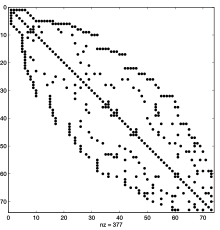Cuthill–McKee algorithm
In numerical linear algebra, the Cuthill–McKee algorithm (CM), named for Elizabeth Cuthill and James[1] McKee,[2] is an algorithm to permute a sparse matrix that has a symmetric sparsity pattern into a band matrix form with a small bandwidth. The reverse Cuthill–McKee algorithm (RCM) due to Alan George is the same algorithm but with the resulting index numbers reversed.[3] In practice this generally results in less fill-in than the CM ordering when Gaussian elimination is applied.[4]


The Cuthill McKee algorithm is a variant of the standard breadth-first search algorithm used in graph algorithms. It starts with a peripheral node and then generates levels for until all nodes are exhausted. The set is created from set by listing all vertices adjacent to all nodes in . These nodes are listed in increasing degree. This last detail is the only difference with the breadth-first search algorithm.
Algorithm
Given a symmetric matrix we visualize the matrix as the adjacency matrix of a graph. The Cuthill–McKee algorithm is then a relabeling of the vertices of the graph to reduce the bandwidth of the adjacency matrix.
The algorithm produces an ordered n-tuple of vertices which is the new order of the vertices.
First we choose a peripheral vertex (the vertex with the lowest degree) and set .
Then for we iterate the following steps while
- Construct the adjacency set of (with the i-th component of ) and exclude the vertices we already have in
- Sort with ascending vertex order (vertex degree).
- Append to the Result set .
In other words, number the vertices according to a particular breadth-first traversal where neighboring vertices are visited in order from lowest to highest vertex order.
See also
References
- Recommendations for ship hull surface representation, page 6
- E. Cuthill and J. McKee. Reducing the bandwidth of sparse symmetric matrices In Proc. 24th Nat. Conf. ACM, pages 157–172, 1969.
- http://ciprian-zavoianu.blogspot.ch/2009/01/project-bandwidth-reduction.html
- J. A. George and J. W-H. Liu, Computer Solution of Large Sparse Positive Definite Systems, Prentice-Hall, 1981
- Cuthill–McKee documentation for the Boost C++ Libraries.
- A detailed description of the Cuthill–McKee algorithm.
- symrcm MATLAB's implementation of RCM.
- reverse_cuthill_mckee RCM routine from SciPy written in Cython.